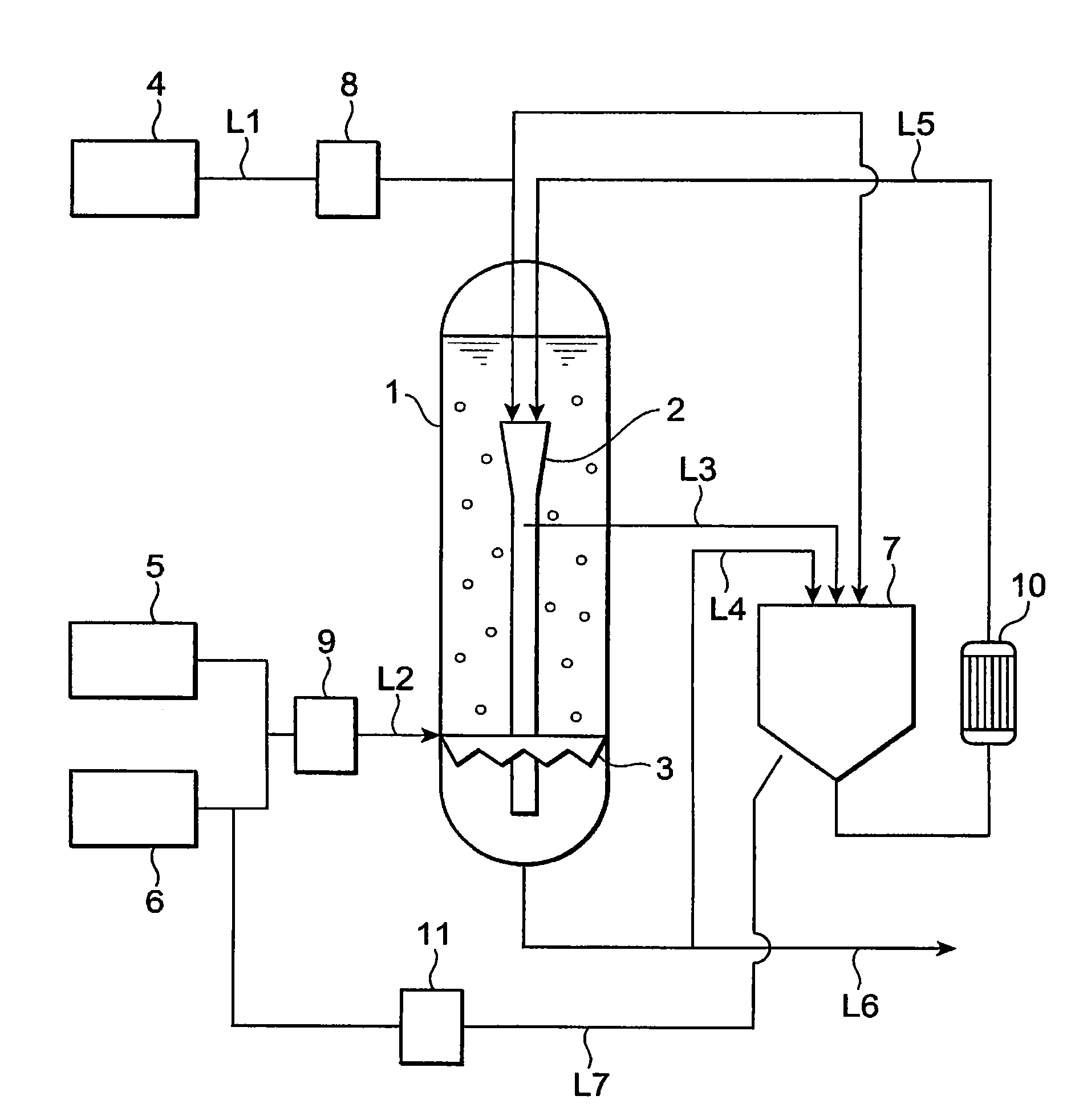Process for producing alkali metal hydrogencarbonate
a technology of alkali metal hydrogencarbonate and hydrogen carbonate, which is applied in the direction of alkali metal carbonates, alkali metal sulfites/sulfates, lithium compounds, etc., can solve the problems of reducing the yield of large crystals, increasing the proportion of fine particulate crystals, and increasing the total number of crystals, so as to achieve easy and certainly control the apparent number of nuclei, large particle size, and excellent flowability
- Summary
- Abstract
- Description
- Claims
- Application Information
AI Technical Summary
Benefits of technology
Problems solved by technology
Method used
Image
Examples
example 1
[0050]To the crystallizer 1, the raw material solution was supplied constantly at a rate of 100 kg / hr by the raw material solution supply line L1, and at the same time, a mixed gas of carbon dioxide at a concentration of from 40 to 43% / air was continuously supplied by the carbon dioxide blowing line L2 at a flow rate of 30 m3 / hr (standard state).
[0051]Further, from the inner cylinder 2 in the crystallizer 1, the slurry was withdrawn at a rate of 800 kg / hr by the slurry withdrawing line L3 into the dissolution apparatus 7 (inner diameter: 0.4 m, height: 3.1 m) and returned to the atmospheric pressure. Further, this liquid was returned to the inlet (upper side) of the inner cylinder 2 via the heat exchanger 10 (temperature: 67° C.) by the slurry recycling line L5. The amount of the slurry withdrawn from the crystallizer 1 by the slurry withdrawing line L6, was adjusted depending upon the amount of the raw material solution supplied to maintain the liquid level in the crystallizer 1 to...
example 2
Comparative Example
[0054]Crystallization was carried out under the same conditions as in Example 1 except that the withdrawal of the slurry from the inner cylinder 2 in the crystallizer 1 by the slurry withdrawing line L3 in Example 1 was stopped. The flow rate of the raw material solution supplied was 100 kg / hr, the flow rate of carbon dioxide supplied was 30 m3 / hr (standard state). The analysis was carried out in the same manner as in Example 1, and the results are shown in Table 2. In Example 2, even after completion of crystallization on the first day after initiation of the crystallization test, the crystals stayed to be microsized at a level of about 50 μm. Accordingly, the test was terminated at that point in time.
[0055]
TABLE 2ApparentComposition of the solution (mass %)Averagenumber ofNumberRaw materialMother liquor inparticlenucleiof dayssolutionthe crystallizersizeformedpassedNa2CO3NaHCO3Na2CO3NaHCO3(μm)(number)120.22.14.711.2513.5 × 1013
example 3
[0056]Into the crystallizer 1, the raw material solution was supplied constantly at a rate of 200 kg / hr by the raw material solution supply line L1, and at the same time, a mixed gas of carbon dioxide at a concentration of from 40 to 43% / air was continuously supplied by the carbon dioxide blowing line L2 at a flow rate of 54 m3 / hr (standard state).
[0057]Further, from the inner cylinder 2 in the crystallizer 1, the slurry was withdrawn at a rate of 1,200 kg / hr by the slurry withdrawing line L3 into the dissolution apparatus 7 and returned to the atmospheric pressure. Further, air was passed through the membrane filter 11 of 0.1 μm and then blown at a rate of 120 liter / hr (standard state) from the air blowing line L7, and then, this liquid was returned to the inlet (the upper side) of the inner cylinder 2 via the heat exchanger 10 (temperature: 82° C.) by the slurry recycling line L5. The amount of the slurry withdrawn from the crystallizer 1 by the slurry withdrawing line L6 was adju...
PUM
| Property | Measurement | Unit |
|---|---|---|
| temperature | aaaaa | aaaaa |
| particle size | aaaaa | aaaaa |
| pressure | aaaaa | aaaaa |
Abstract
Description
Claims
Application Information
 Login to View More
Login to View More - R&D
- Intellectual Property
- Life Sciences
- Materials
- Tech Scout
- Unparalleled Data Quality
- Higher Quality Content
- 60% Fewer Hallucinations
Browse by: Latest US Patents, China's latest patents, Technical Efficacy Thesaurus, Application Domain, Technology Topic, Popular Technical Reports.
© 2025 PatSnap. All rights reserved.Legal|Privacy policy|Modern Slavery Act Transparency Statement|Sitemap|About US| Contact US: help@patsnap.com

